Application of Chemical Sequence Stratigraphy to the Prediction of Shale Gas Sweet Spots in the Wufeng and Lower Longmaxi Formations within the Upper Yangtze Region
Abstract
:1. Introduction
2. Theories and Methods
2.1. Optimum Geochemical Element Combination Index
2.2. Establishing the Chemical Sequence Stratigraphy Theory Model
2.3. Dividing Geochemical Facies
- (1)
- (2)
- The main aim of the enrichment factor transformation of elements is to clearly determine whether an element is rich or deficient within a sample [33], and the calculation formula is the ratio of the standardized Al value of an element in the shale samples to the standardized Al value of the same element of the world average shale [42,43,44],where AS represents “global average shale.” When EF-X is equal to 1, the element X of this sample has the same enrichment degree as that of globally average shale; when EF-X is less than 1, X of this sample is less deficient than that of globally average shale; and when EF-X is greater than 1, X of this sample is richer than that of globally average shale [10]. In our method, we divide the value of EF-X into six levels: EF-X < 0.1 is extremely deficient, 0.1 ≤ EF-X < 0.5 is deficient, 0.5 ≤ EF-X < 1 is slightly deficient, 1 ≤ EF-X < 2 is slightly rich, 2 ≤ EF-X < 5 is rich, and EF-X ≥ 5 is extremely rich.EF transformative value of the element (X): EF-X = (X/Al)sample/(X/Al)AS,
2.4. Evaluation Key Chemical Parameters
3. Section and Samples
4. Data Processing and Analysis
4.1. Data Processing
4.2. Data Analysis and Index Optimization
5. Results and Discussion
5.1. Chemical Sequence Stratigraphy Division of HD1
5.2. Geochemical Facies Division of HD1
5.3. Sweet Spot Prediction based on HD1
5.4. Comparative Study of the Upper Yangtze
6. Conclusions
Author Contributions
Funding
Data Availability Statement
Acknowledgments
Conflicts of Interest
References
- Jiang, Z.X.; Song, Y.; Tang, X.L.; Li, Z.; Wang, X.M.; Wang, G.Z.; Xue, Z.X.; Li, X.; Zhang, K.; Chang, J.Q.; et al. Controlling factors of marine shale gas differential enrichment in southern China. Pet. Explor. Dev. Online 2020, 47, 617–628. [Google Scholar] [CrossRef]
- Guo, X.S.; Hu, D.F.; Wen, Z.D.; Liu, R.B. Major factors controlling the accumulation and high productivity in marine shale gas in the Lower Paleozoic of Sichuan Basin and its periphery: A case study of the Wufeng-Longmaxi Formation of Jiaoshiba area. Geol. China 2014, 41, 893–901. [Google Scholar]
- Tang, X.L.; Jiang, Z.X.; Li, Z.; Gao, Z.Y.; Bai, Y.Q.; Zhao, S.; Feng, J. The effect of the variation in material composition on the heterogeneous pore structure of high-maturity shale of the Silurian Longmaxi formation in the southeastern Sichuan Basin, China. J. Nat. Gas Sci. Eng. 2015, 23, 464–473. [Google Scholar] [CrossRef]
- Zhao, W.Z.; Li, J.Z.; Yang, T.; Wang, S.F.; Huang, J.L. Geological difference and its significance of marine shale gases in South China. Pet. Explor. Dev. 2016, 43, 499–510. [Google Scholar] [CrossRef]
- Jin, Z.J.; Hu, Z.Q.; Gao, B.; Zhao, J.H. Controlling factors on the enrichment and high productivity of shale gas in the Wufeng-Longmaxi Formations, southeastern Sichuan Basin. Earth Sci. Front. 2016, 23, 1–10. [Google Scholar]
- Zhai, G.Y.; Wang, Y.F.; Bao, S.J.; Guo, T.X.; Zhou, Z.; Chen, X.L.; Wang, J.Z. Major factors controlling the accumulation and high productivity of marine shale gas and prospect forecast in the southern China. Earth Sci. 2017, 42, 1057–1068. [Google Scholar]
- Qiu, Z.; Zou, C.N.; Wang, H.Y.; Dong, D.Z.; Lu, B.; Chen, Z.H.; Liu, D.X.; Li, G.Z.; Liu, H.L.; He, J.L.; et al. Discussion on characteristics and controlling factors of differential enrichment of Wufeng-Longmaxi Shale gas in South China. Nat. Gas Geosci. 2020, 5, 117–128. [Google Scholar] [CrossRef]
- Zou, C.N.; Zhao, Q.; Cong, L.T.; Wang, H.Y.; Shi, Z.S.; Wu, J.; Pan, S.Q. Development progress, potential and prospect of shale gas in China. Nat. Gas Ind. 2021, 41, 1–14. [Google Scholar]
- Zhai, G.Y.; Li, J.; Jiao, Y.; Wang, Y.F.; Liu, G.H.; Xu, Q.; Wang, C.; Chen, R.; Guo, X.B. Applications of chemostratigraphy in a characterization of shale gas Sedimentary Microfacies and predictions of sweet spots—Taking the Cambrian black shales in Western Hubei as an example. Mar. Pet. Geol. 2019, 109, 547–560. [Google Scholar] [CrossRef]
- La Grange, M.T.; Konhauser, K.O.; Catuneanu, O.; Brette, S.H.; Tiffany, L.P.; Murray, K.G. Sequence stratigraphy in organic-rich marine mudstone successions using chemostratigraphic datasets. Earth-Sci. Rev. 2020, 203, 103137. [Google Scholar] [CrossRef]
- Schoepfer, S.D.; Shen, J.; Wei, H.; Tyson, R.V.; Ingall, E.; Thomas, J.A. Total organic carbon, organic phosphorus, and biogenic barium fluxes as proxies for paleomarine productivity. Earth-Sci. Rev. 2014, 149, 23–52. [Google Scholar] [CrossRef]
- Qiu, Z.; Zou, C.N. Controlling factors on the formation and distribution of “sweet-spot areas” of marine gas shales in South China and a preliminary discussion on unconventional petroleum sedimentology. J. Asian Earth Sci. 2020, 194, 103989. [Google Scholar] [CrossRef]
- Li, J.T.; Liu, J.B.; Sun, Y.C.; Yan, Z.; Wu, R.C.; Zhan, R.B. On the Lower Ordovician Lunshan Formation in Lower Yangtze Region, South China: Its petrology, stratigraphy and palaeogeography. J. Paleogeography 2016, 18, 411–423. [Google Scholar]
- Wang, Y.Q.; Li, Q.; Bai, B.; Zhang, Z.Q.; Xu, R.C.; Wang, X.Y.; Zhang, X. Lithostratigraphic subdivision and correlation of the Paleogene in China. J. Stratigr. 2021, 45, 402–425. [Google Scholar]
- Nie, H.K.; Li, D.H.; Jiang, T.; Yan, C.N.; Du, W.; Zhang, G.R. Logging isochronous stratigraphic division of shale based on characteristics of graptolite zones and its significance: A case study of Wufeng Formation-Longmaxi Formation in Sichuan Basin and its periphery. Acta Pet. Sin. 2020, 41, 273–283. [Google Scholar]
- Li, Y.X.; Ji, Z.S.; Wu, G.C. New Progress on the early Triassic conodont biostratigraphy in the Coqun area, Lhasa terrane. Acta Micropalaeontologica Sin. 2021, 38, 334–351. [Google Scholar]
- Banner, J.L. Radiogenic isotopes: Systematics and applications to earth surface processes and chemical stratigraphy. Earth-Sci. Rev. 2004, 65, 141–194. [Google Scholar] [CrossRef]
- Traversi, R.; Becagli, S.; Castellano, E.; Cerri, O.; Morganti, A.; Severi, M.; Udisti, R. Study of Dome C site (East Antartica) variability by comparing chemical stratigraphies. Microchem. J. 2009, 92, 7–14. [Google Scholar] [CrossRef]
- Posamentier, H.W.; Vail, P.R. Eustatic controls on clastic deposition II—sequenceand systems tract model. In Sea Level Changes—An Integrated Approach; Wilgus, C.K., Hastings, B.S., Ross, C.A., Posamentier, H., Van Wagoner, J., Kendall, C., Eds.; Special Publication; Society of Economic Paleontologists and Mineralogists, (SEPM): Tulsa, OK, USA, 1988; Volume 42, pp. 125–154. [Google Scholar]
- Haq, B.U.; Hardenbol, J.; Vail, P.R. Mesozoic and cenozoic chronostratigraphy and cycles of sea-level change. In Sea-Level Changes—An Integrated Approach; SEPM Special Publication; SEPM: Tulsa, OK, USA, 1988; Volume 42, pp. 71–108. [Google Scholar]
- Zheng, R.C.; Wen, H.G.; Li, F.J. High-Resolution Sequence Stratigraphy; Geological Publishing House: Beijing, China, 2010; pp. 1–404. [Google Scholar]
- Li, Y.F.; Fan, T.L.; Gao, Z.Q.; Zhang, J.C.; Wang, X.M.; Zeng, W.T.; Zhang, J.P. Sequence stratigraphy of Silurian black shale and its disturbution in the southeast area of Chongqing. Nat. Gas Geosci. 2012, 23, 299–306. [Google Scholar]
- Wang, T.; Yang, K.M.; Xiong, L.; Shi, H.L.; Zhang, Q.L.; Wei, L.M.; He, X.L. Shale sequence stratigraphy of Wufeng-Longmaxi Formation in southern Sichuan and their control on reservoirs. Acta Pet. Sin. 2015, 36, 915–925. [Google Scholar]
- Wang, Y.M.; Dong, D.Z.; Li, X.J.; Huang, J.L.; Wang, S.F.; Wu, W. Stratigraphic sequence and sendimentary characteristics of Lower Sliurian Longmaxi Formation in Sichuan Basin and its peripheral area. Nat. Gas Ind. 2015, 35, 12–21. [Google Scholar]
- Guo, X.S. Sequence stratigraphy and evolution model of the Wufeng-Longmaxi shale in the upper Yangtze area. Earth Sci. 2017, 42, 1069–1082. [Google Scholar]
- Pearce, T.J.; Wray, D.; Ratcliffe, K.T.; Wright, D.K.; Moscariello, A.; Collinson, J.D.; Jones, N.S. Chemostratigraphy of the Upper Carboniferous Schooner Formation, southern North Sea. In Carboniferous Hydrocarbon Resources: The Southern North Sea and Surrounding Onshore Areas; Collinson, J.D., Evans, D.J., Holliday, D.W., Eds.; Occasional Publication Series of the Yorkshire Geological Society: Yorkshire, UK, 2005; Volume 7, pp. 147–164. [Google Scholar]
- Ratcliffe, K.T.; Wright, A.M.; Schmidt, K. Application of inorganic whole-rock geochemistry to shale resource plays: An example from the Eagle Ford Shale Formation, Texas. Sediment. Rec. 2012, 10, 4–9. [Google Scholar] [CrossRef]
- Sano, J.L.; Ratcliffe, K.T.; Spain, D. Chemostratigraphy of the Haynesville Shale. In Geology of the Haynesville Gas Shale in East Texas and West Louisiana, USA; Hammes, U., Gale, J., Eds.; AAPG Memoir: Tulsa, OK, USA, 2013; Volume 105, pp. 137–154. [Google Scholar]
- Nyhuis, C.J.; Riley, D.; Kalasinska, A. Thin section petrography and chemostratigraphy: Integrated evaluation of an upper Mississippian mudstone dominated succession from the southern Netherlands. Neth. J. Geosci. 2016, 95, 3–22. [Google Scholar] [CrossRef] [Green Version]
- Turner, B.W. Utilization of Chemostratigraphic Proxies for Generating and Refining Sequence Stratigraphic Frameworks in Mudrocks and Shales. Ph.D. Thesis, University of Oklahoma Graduate College, Norman, OK, USA, 2016; pp. 1–98. [Google Scholar]
- Wang, Q.; Huang, Y.J.; Zhang, Z.F.; Wang, C.H.; Li, X.; Liu, W. High resolution chemical sequence stratigraphy analysis of Wufeng Formation and lower Longmaxi formation in the well Xindi 1, upper Yangtze Region. Geol. China. 2020. Available online: https://kns.cnki.net/kcms/detail/detail.aspx?FileName=DIZI20201220002&DbName=CAPJ2020. (accessed on 22 December 2020).
- Ramkumar, M. Chemostratigraphy: Concepts, Techniques, and Applications; Elsevier: Amsterdam, The Netherlands, 2015; pp. 1–432. [Google Scholar]
- Craigie, N. Principles of Elemental Chemostratigraphy—A Practical User Guide; Springer: Berlin, Germany, 2018; pp. 1–177. [Google Scholar]
- Sial, A.N.; Gaucher, C.; Ramkumar, M.; Ferreira, V.P. Introduction: Chemostratigraphy as a formal stratigraphic method. In Chemostratigraphy across Major Chronological Boundaries; Sial, A.N., Gaucher, C., Ramkumar, M., Ferreira, V.P., Eds.; AGU Geophysical Monograph Series; Wiley: Hoboken, NJ, USA, 2019; pp. 3–25. [Google Scholar]
- Tribovillard, N.; Algeo, T.J.; Lyons, T.; Riboulleau, A. Trace metals as paleoredox and paleoproductivity proxies: An update. Chem. Geol. 2006, 232, 12–32. [Google Scholar] [CrossRef]
- Mørk, A.; Embry, A.F.; Weitschat, W. Triassic transgressive-regressive cycles in the Sverdrup Basin, Svalbard and the Barents Shelf. In Correlation in Hydrocarbon Exploration; Collinson, J.D., Ed.; Springer: Dordrecht, The Netherlands, 1989. [Google Scholar]
- Dromart, G.; Monier, P.; Curial, A.; Moretto, R.; Guillocheau, F. Triassic Transgressive-Regressive Cycles in the Bresse-Jura and Adjacent Basins, Eastern France. In Hydrocarbon and Petroleum Geology of France; Mascle, A., Ed.; Special Publication of the European Association of Petroleum Geoscientists; Springer: Berlin/Heidelberg, Germany, 1994; Volume 4. [Google Scholar]
- Lü, M.; Chen, K.; Xue, L.; Yi, L.; Zhu, H. High-resolution transgressive-regressive sequence stratigraphy of Chang 8 Member of Yanchang Formation in southwestern Ordos basin, northern China. J. Earth Sci. 2010, 21, 423–438. [Google Scholar] [CrossRef]
- Montero-Serrano, J.C.; Palarea-Albaladejo, J.; Martin-Fernandez, J.A.; Martínez-Santana, M.; Gutiérrez-Martín, J.V. Sedimentary chemofacies characterization by means of multivariate analysis. Sediment. Geol. 2010, 228, 218–228. [Google Scholar] [CrossRef]
- Calvert, S.E.; Pedersen, T.F. Geochemistry of Recent oxic and anoxic marine sediments: Implications for the geological record. Mar. Geol. 1993, 113, 67–88. [Google Scholar] [CrossRef]
- Turgeon, S.; Brumsack, H.J. Anoxic vs dysoxic events reflected in sediment geochemistry during the Cenomanian-Turonian Boundary Event (Cretaceous)in the Umbria-Marche Basin of central Italy. Chem. Geol. 2006, 234, 321–339. [Google Scholar] [CrossRef]
- Wedepohl, K.H. Environmental influences on the chemical composition of shales and clays. In Physics and Chemistry of the Earth; Ahrens, L.H., Press, F., Runcorn, S.K., Eds.; Pergamon: Oxford, UK, 1971; pp. 305–333. [Google Scholar]
- Li, Y.H.; Schoonmaker, J.E. Chemical composition and mineralogy of marine sediments. In Treatise on Geochemistry, Sediments, Diagenesis, and Sedimentary Rocks; Rudnick, R.L., Ed.; Elsevier Sciences: New York, NY, USA, 2003; Volume 7, pp. 1–35. [Google Scholar]
- Li, G.Q.; Cheng, W.B.; Zhang, Y.M.; Zhang, Y.; Lv, P.R.; Dai, H.Z.; Zhang, X.G.; Xia, B.B. Geochemical Characteristics and Their Geologic Significance of the Lower Jurassic Ridang Formation Host Strata from the Zhaxikang Sb-Pb-Zn-Ag Polymetallic Ore-concentrated District, South Tibet. Bull. Mineral. Petrol. Geochem. 2014, 33, 598–608. [Google Scholar]
- Xu, Z.Y.; Liang, X.; Wang, W.X.; Zhang, J.H.; Wang, X.Y.; Shu, H.L.; Huang, C.; Wang, G.C.; Lu, H.L.; Liu, C.; et al. Controlling factors for shale gas sweet spots distribution in the Upper Yangtze region: A case study of the Upper Ordovician Wufeng Fm–Lower Silurian Longmaxi Fm, Sichuan Basin. Nat. Gas Ind. 2016, 36, 35–43. [Google Scholar]
- Zou, C.N.; Dong, D.Z.; Wang, Y.M.; Li, X.J.; Huang, J.L.; Wang, S.F.; Guan, Q.Z.; Zhang, C.C.; Wang, H.Y.; Liu, H.L.; et al. Shale gas in China: Characteristics, challenges and prospects (II). Pet. Explor. Dev. 2016, 43, 166–178. [Google Scholar] [CrossRef]
- Xie, X.N.; Hao, F.; Lu, Y.C.; He, S.; Shi, W.Z.; Jiang, Z.X.; Xiong, Y.Q.; Zhang, J.C. Differential enrichment mechanism and key technology of shale gas in complex areas of south China. Earth Sci. 2017, 42, 1045–1056. [Google Scholar]
- Bowker, K.A. Barnett Shale gas production, Fort Worth Basin: Issues and discussion. AAPG Bull. 2007, 91, 523–533. [Google Scholar] [CrossRef]
- Dong, D.Z.; Cheng, K.M.; Wang, S.Q.; Lv, Z.G. An evaluation method of shale gas resource and its application in the Sichuan basin. Nat. Gas Ind. 2009, 29, 33–39. [Google Scholar]
- Ross, D.J.; Bustin, R.M. The importance of shale composition and pore structure upon gas storage potential of shale gas reservoirs. Mar. Pet. Geol. 2009, 26, 916–927. [Google Scholar] [CrossRef]
- Palarea-Albaladejo, J.; Martín-Fernández, J.A.; Gómez-García, J. A parametric approach for dealing with compositional rounded zeros. Math. Geol. 2007, 39, 625–645. [Google Scholar] [CrossRef]
- Martin-Fernandez, J.A.; Barcelo-Vidal, C.; Pawlowsky-Glahn, V. Dealing with zeros and missing values in compositional data sets using nonparametric imputation. Math. Geol. 2003, 35, 253–278. [Google Scholar] [CrossRef]
- Martín-Fernández, J.A.; Barceló-Vidal, C.; Pawlowsky-Glahn, V.; Kovács, L.Ó.; Kovács, G.P. Subcompositional patterns in Cenozoic volcanic rocks of Hungary. Math. Geol. 2005, 37, 729–752. [Google Scholar] [CrossRef]
- Pison, G.; Rousseeuw, P.J.; Filzmoser, P.; Croux, C. Robust factor analysis. J. Multivar. Anal. 2003, 84, 145–172. [Google Scholar] [CrossRef] [Green Version]
- Filzmoser, P.; Hron, K. Outlier detection for compositional data using robust methods. Math. Geosci. 2008, 40, 233–248. [Google Scholar] [CrossRef]
- Reiman, C.; Filmoser, P. Normal and lognormal data distribution in geochemistry: Death of a myth. Consequences for the statistical treatment of geochemical and environmental data. Environ. Geol. 2000, 39, 1001–1014. [Google Scholar] [CrossRef]
- Catuneanu, O.; Abreu, V.; Bhattacharya, J.; Blum, M.; Dalrymple, R.; Eriksson, P.; Fielding, C.; Fisher, W.; Galloway, W.; Gibling, M.; et al. Towards the standardization of sequence stratigraphy. Earth-Sci. Rev. 2009, 92, 1–33. [Google Scholar] [CrossRef] [Green Version]
- Lin, C.S.; Zhang, Y.M.; Liu, J.Y.; Pang, B.C. High resolution sequence stratigraphy and reservoir prediction. Earth Sci. Front. 2000, 7, 111–117. [Google Scholar]
- He, J.L.; Wang, J.; Yu, Q.; Liu, W.; Ge, X.Y.; Yang, P.; Wang, Z.J.; Lu, J.Z. Pore structure of shale and its effects on gas storage and transmission capacity in well HD-1 eastern Sichuan Basin. China Fuel 2018, 226, 709–720. [Google Scholar] [CrossRef]
- Wang, Y.M.; Li, X.J.; Dong, D.Z.; Zhang, C.C.; Wang, S.F. Main factors controlling the sedimentation of high-quality shale in Wufeng–Longmaxi Fm, Upper Yangtze region. Nat. Gas Ind. 2017, 37, 9–20. [Google Scholar] [CrossRef]
- Wang, Q.; Huang, Y.J.; Zhang, Z.F.; Wang, C.H.; Li, X.; Liu, W. Application of high-resolution chemical sequence stratigraphy to Deep-water fine-grained sediments—a case study of the Wufeng Formation and the lower member of Longmaxi formation in Liutang outcrop, upper Yangtze Region. Geoscience 2021, 35, 281–292. [Google Scholar]
- Wang, Q.; Huang, Y.J.; Zhang, Z.F.; Wang, C.H.; Li, X.; Liu, W. Chemical sequence stratigraphy of the Wufeng Formation-lower member of Longmaxi formation in Shuanghe outcrop, upper Yangtze Region. Northwestern Geol. 2021, 54, 1–14. [Google Scholar]


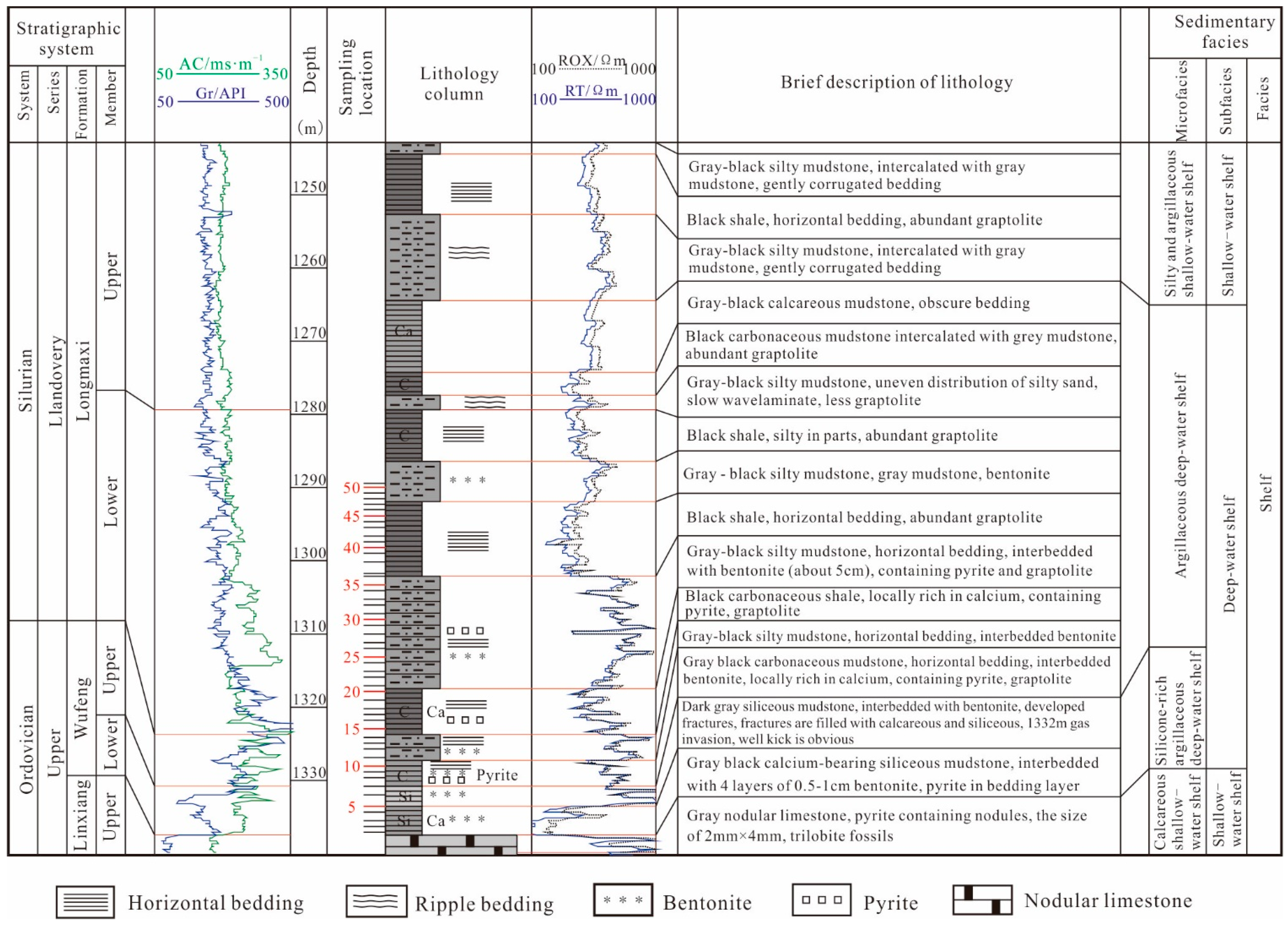
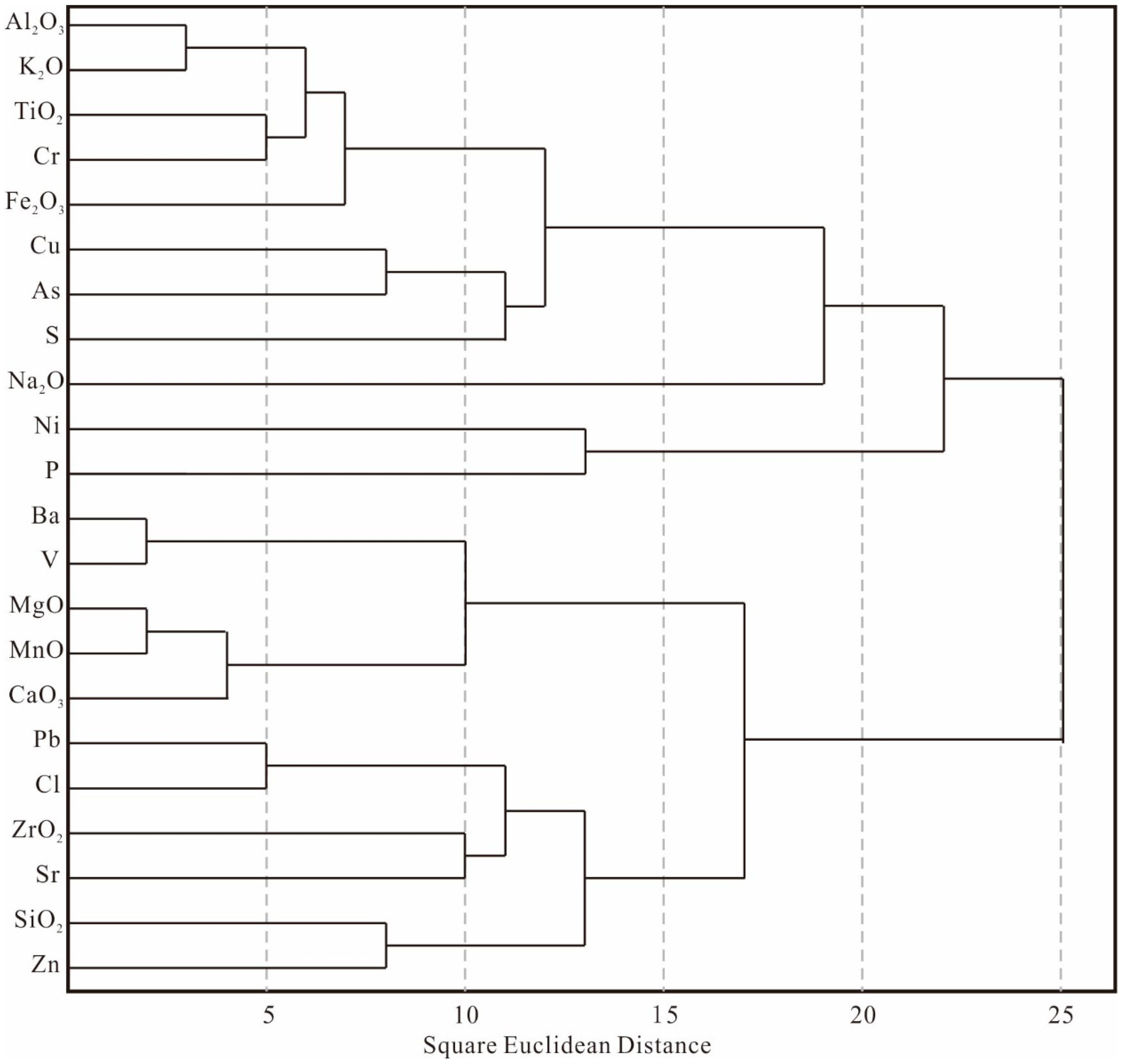
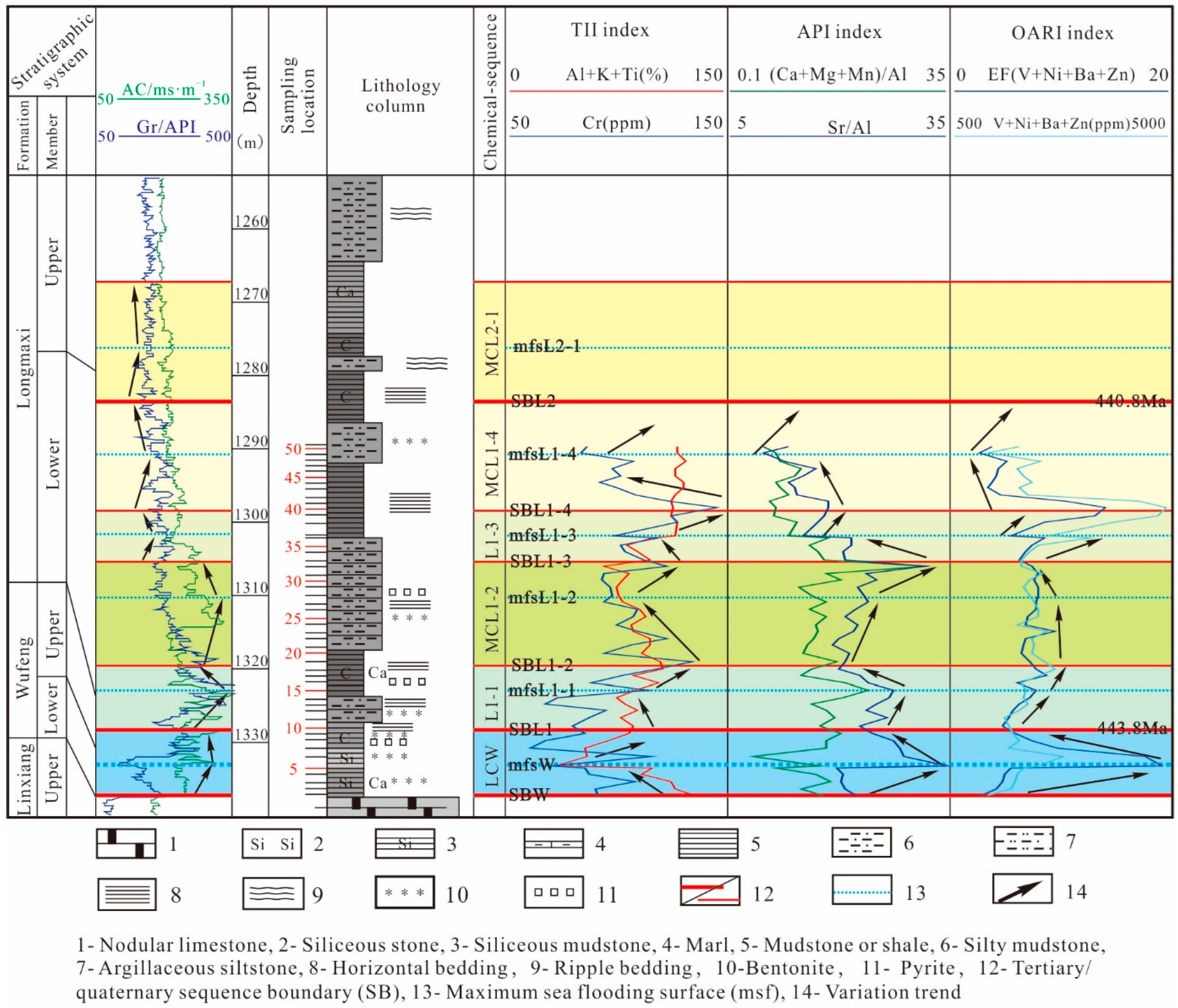


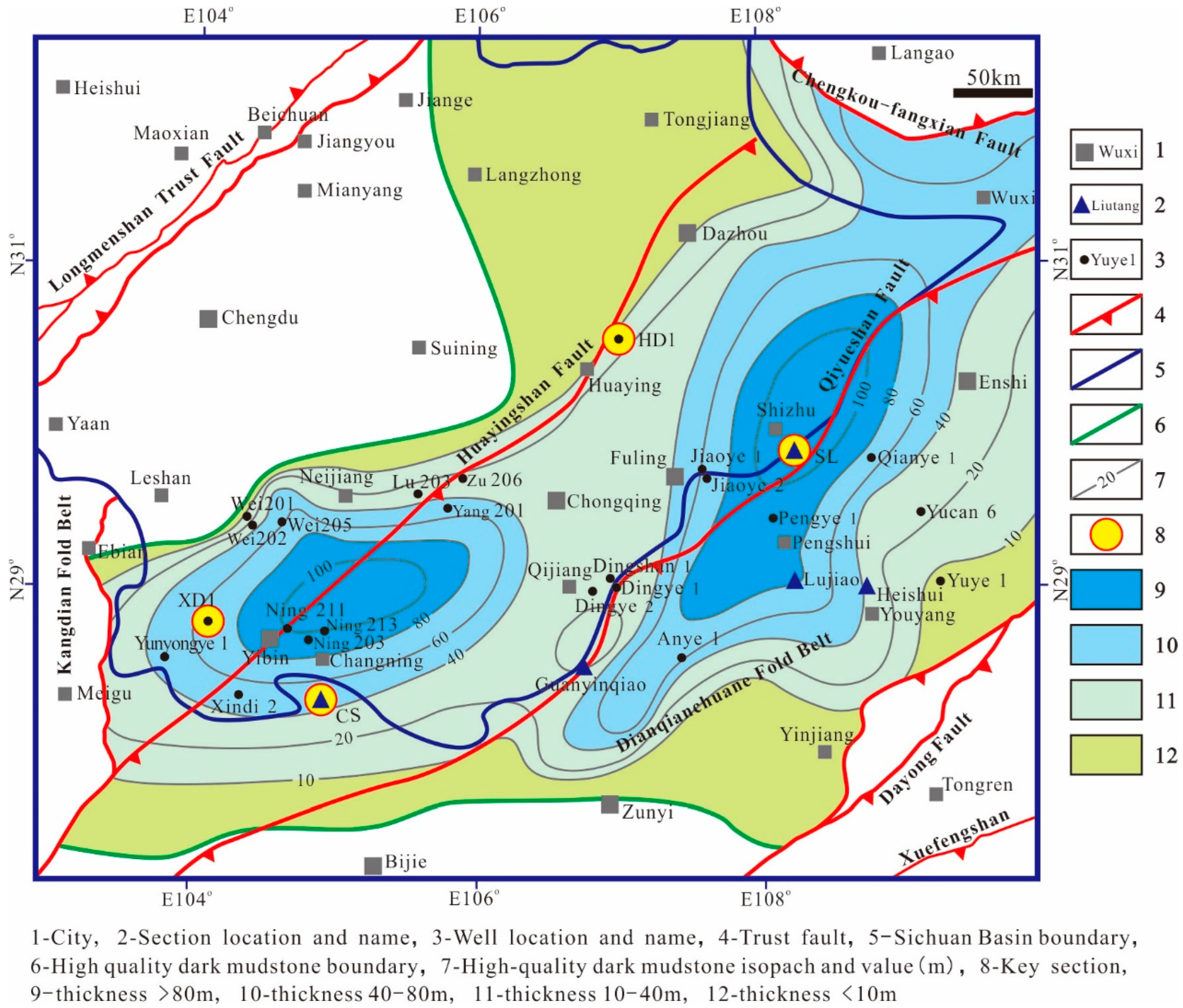
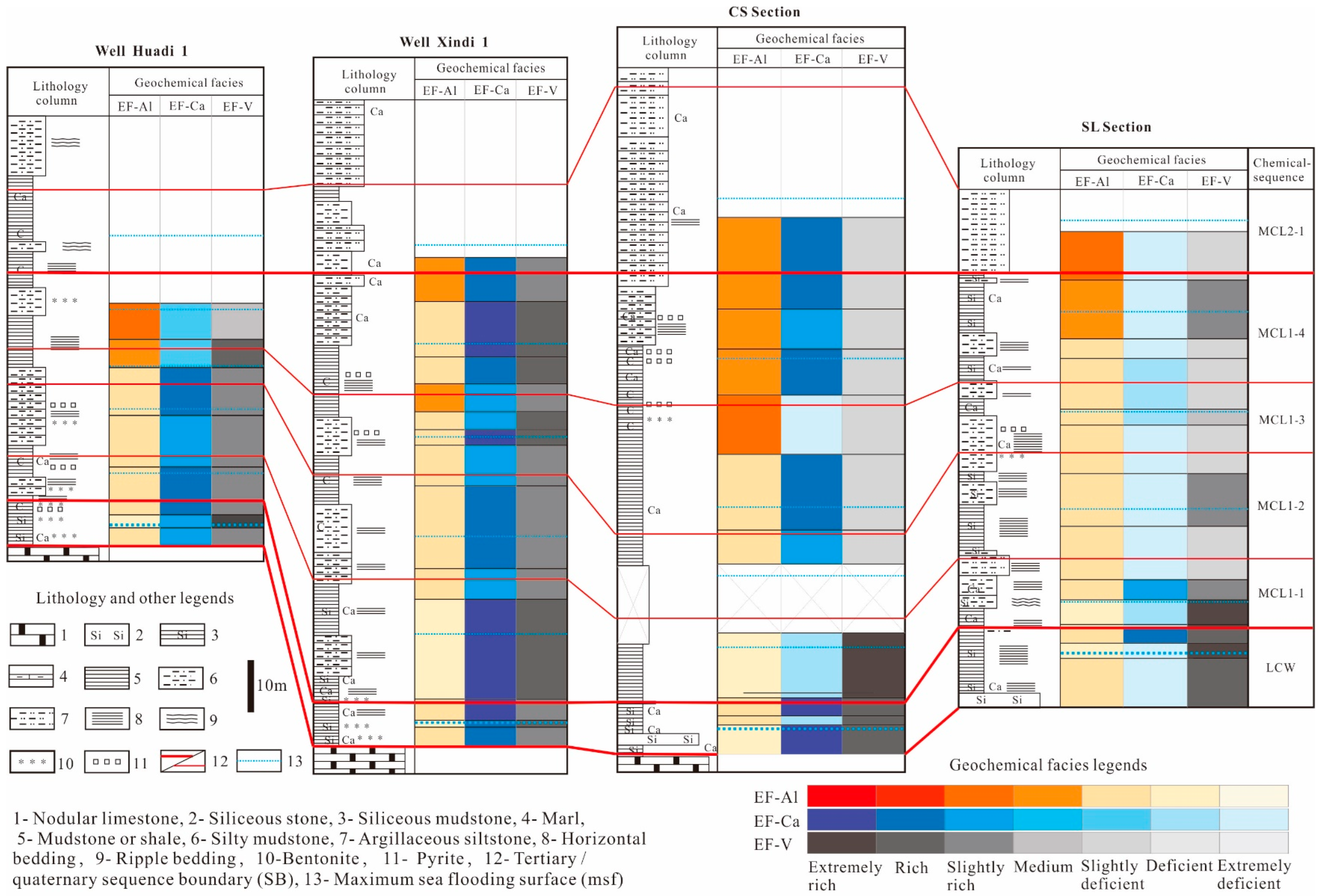

| Elements | Associated Minerals | Genetic Significance |
|---|---|---|
| Si | Quartz, other silicates | Terrigenous/Authigenic |
| Al, Ga | Mainly clay minerals, a small amount related to feldspar | Terrigenous |
| K, Rb | Potash feldspar, mica, and clay minerals (especially illite) | Terrigenous |
| Cs, Sc | Clay minerals and feldspar | Terrigenous |
| V | Mainly clay minerals (V adsorbed on clay minerals under anoxic conditions) | Reduction |
| Ca | Mainly calcite and dolomite; also gypsum and anhydrite, and to a lesser extent with montmorillonite and plagioclase | Mainly authigenic |
| Mg | Mainly dolomite, calcite, or clay minerals (especially chlorite) | Mainly authigenic |
| Fe, Mn | Various clay, carbonate minerals, and pyrite | Terrigenous/Authigenic |
| Na | mainly plagioclase; some sodium is related to stone salts or clay minerals (montmorillonite) | Terrigenous/Authigenic |
| Ti, Ta, Nb | Titanium magnetite, magnetite, ilmenite, rutile, anatase, sphalerite | Terrigenous |
| Th | Heavy minerals, especially monazite, zircon, and apatite | Terrigenous |
| REE | Light rare earth elements are most abundant in clay minerals and feldspar, while heavy rare earth elements are found in heavy minerals. | Terrigenous |
| U | Heavy mineral, organic matter | Terrigenous/Reduction |
| Cr | Heavy minerals (chrome spinel) | Terrigenous |
| Zr, Hf | Zircon | Terrigenous |
| P | Biological phosphorus, phosphorous heavy minerals (apatite and monazite); small amounts of phosphorus associated with carbonate and clay minerals | Authigenic |
| Zn, Ni, Mo, Co, Cu | Pyrite, ferric hydroxide, carbonate, clay minerals | Authigenic/Terrigenous |
| Ba | Carbonate (barite) | Authigenic |
| Sr | Feldspar, clay minerals, carbonate | Terrigenous/Authigenic |
| Fe2O3 | Al2O3 | K2O | Na2O | MgO | TiO2 | ZrO2 | CaO | SiO2 | MnO | V | Cr | Ni | Zn | Cu | Ba | P | As | Pb | Sr | S | Cl | |
|---|---|---|---|---|---|---|---|---|---|---|---|---|---|---|---|---|---|---|---|---|---|---|
| Fe2O3 | 1.00 | |||||||||||||||||||||
| Al2O3 | 0.63 | 1.00 | ||||||||||||||||||||
| K2O | 0.44 | 0.92 | 1.00 | |||||||||||||||||||
| Na2O | 0.01 | 0.03 | −0.03 | 1.00 | ||||||||||||||||||
| MgO | 0.48 | 0.35 | 0.28 | 0.12 | 1.00 | |||||||||||||||||
| TiO2 | 0.57 | 0.61 | 0.54 | −0.02 | 0.12 | 1.00 | ||||||||||||||||
| ZrO2 | −0.60 | −0.36 | −0.18 | 0.18 | −0.34 | −0.30 | 1.00 | |||||||||||||||
| CaO | −0.13 | −0.25 | −0.03 | 0.21 | 0.53 | −0.25 | 0.26 | 1.00 | ||||||||||||||
| SiO2 | −0.59 | −0.63 | −0.69 | −0.07 | −0.57 | −0.50 | 0.16 | −0.36 | 1.00 | |||||||||||||
| MnO | 0.54 | 0.24 | 0.19 | −0.04 | 0.89 | 0.18 | −0.48 | 0.48 | −0.49 | 1.00 | ||||||||||||
| V | 0.31 | 0.16 | 0.16 | −0.20 | −0.07 | 0.78 | −0.17 | −0.20 | −0.13 | 0.10 | 1.00 | |||||||||||
| Cr | 0.46 | 0.28 | 0.32 | −0.12 | 0.29 | 0.60 | −0.28 | 0.12 | −0.29 | 0.39 | 0.81 | 1.00 | ||||||||||
| Ni | −0.10 | −0.40 | −0.33 | 0.03 | −0.37 | −0.01 | 0.37 | −0.01 | 0.28 | −0.33 | 0.40 | 0.35 | 1.00 | |||||||||
| Zn | −0.25 | −0.31 | −0.22 | −0.21 | −0.24 | −0.27 | 0.30 | 0.04 | 0.40 | −0.22 | 0.23 | 0.31 | 0.59 | 1.00 | ||||||||
| Cu | 0.24 | 0.33 | 0.22 | 0.11 | 0.41 | 0.01 | −0.30 | 0.07 | −0.31 | 0.35 | −0.26 | −0.12 | −0.61 | −0.43 | 1.00 | |||||||
| Ba | 0.39 | 0.19 | 0.12 | −0.13 | −0.04 | 0.85 | −0.27 | −0.27 | −0.19 | 0.15 | 0.91 | 0.62 | 0.24 | −0.06 | −0.21 | 1.00 | ||||||
| P | −0.36 | −0.48 | −0.28 | −0.23 | −0.63 | −0.15 | 0.22 | 0.01 | 0.29 | −0.37 | 0.10 | −0.03 | 0.37 | 0.17 | −0.45 | 0.06 | 1.00 | |||||
| As | 0.15 | 0.28 | 0.23 | −0.03 | 0.51 | −0.01 | −0.30 | 0.12 | −0.34 | 0.39 | −0.23 | −0.09 | −0.54 | −0.32 | 0.39 | −0.10 | −0.40 | 1.00 | ||||
| Pb | 0.00 | −0.20 | −0.16 | 0.26 | −0.24 | −0.11 | 0.03 | −0.05 | 0.07 | −0.23 | −0.13 | −0.23 | 0.22 | −0.22 | −0.18 | −0.03 | 0.14 | −0.26 | 1.00 | |||
| Sr | −0.35 | −0.25 | 0.02 | 0.21 | 0.20 | −0.09 | 0.51 | 0.82 | −0.19 | 0.15 | −0.05 | 0.05 | 0.10 | 0.05 | −0.12 | −0.12 | 0.11 | −0.12 | −0.03 | 1.00 | ||
| S | −0.11 | 0.20 | 0.20 | −0.44 | 0.04 | −0.04 | −0.06 | −0.18 | 0.09 | 0.09 | 0.04 | 0.09 | −0.22 | 0.28 | 0.12 | −0.09 | −0.08 | 0.22 | −0.79 | −0.16 | 1.00 | |
| Cl | −0.02 | 0.06 | 0.19 | 0.40 | −0.05 | 0.05 | 0.10 | 0.19 | −0.01 | −0.06 | 0.00 | 0.07 | 0.12 | −0.09 | −0.17 | −0.05 | 0.03 | −0.22 | 0.57 | 0.37 | −0.48 | 1.00 |
| Main Elemental Oxides | Principal Component 1 | Principal Component 2 | Principal Component 3 | Principal Component 4 | Principal Component 5 |
|---|---|---|---|---|---|
| Fe2O3 | 0.829 | −0.135 | −0.241 | 0.232 | 0.140 |
| Al2O3 | 0.823 | −0.412 | 0.237 | −0.020 | −0.280 |
| K2O | 0.748 | −0.309 | 0.424 | −0.245 | −0.268 |
| Na2O | 0.008 | 0.246 | 0.507 | 0.820 | −0.071 |
| MgO | 0.697 | 0.626 | −0.124 | 0.024 | −0.131 |
| TiO2 | 0.648 | −0.455 | 0.116 | 0.068 | 0.530 |
| ZrO2 | −0.541 | 0.159 | 0.697 | −0.215 | 0.164 |
| CaO | 0.107 | 0.889 | 0.275 | −0.187 | 0.100 |
| SiO2 | −0.825 | −0.158 | −0.346 | 0.176 | −0.134 |
| MnO | 0.682 | 0.585 | −0.356 | −0.017 | 0.043 |
| Trace Elements | Principal Component 1 | Principal Component 2 | Principal Component 3 | Principal Component 4 | Principal Component 5 |
|---|---|---|---|---|---|
| Zr | 0.315 | −0.496 | 0.544 | 0.282 | 0.130 |
| V | 0.638 | 0.663 | −0.293 | 0.118 | 0.097 |
| Cr | 0.506 | 0.661 | −0.219 | 0.320 | −0.158 |
| Ni | 0.853 | −0.063 | 0.163 | −0.132 | −0.212 |
| Zn | 0.532 | 0.161 | 0.599 | −0.029 | −0.473 |
| Cu | −0.724 | 0.136 | −0.190 | 0.203 | −0.058 |
| Ba | 0.483 | 0.606 | −0.474 | 0.025 | 0.282 |
| P | 0.495 | −0.213 | 0.208 | −0.357 | 0.573 |
| As | −0.665 | 0.255 | −0.088 | 0.184 | 0.012 |
| Pb | 0.244 | −0.650 | −0.590 | −0.238 | −0.155 |
| Sr | 0.234 | −0.367 | 0.183 | 0.791 | 0.264 |
| S | −0.269 | 0.574 | 0.631 | 0.027 | 0.026 |
| Cl | 0.299 | −0.513 | −0.440 | 0.389 | −0.203 |
| Sequences/ Key Surfaces | TII Index | API Index | OARI Index | |||
|---|---|---|---|---|---|---|
| Al + K + Ti (%) | Cr (ppm) | (Ca + Mg + Mn)/Al | Sr/Al | V + Ni + Ba + Zn (ppm) | EF(V + Ni + Ba + Zn) | |
| SBL2 | / | / | / | / | / | / |
| mfsL1-4 | 23.70 | 72 | 0.18 | 8.49 | 1234 | 3.74 |
| SBL1-4 | 22.54 | 143 | 0.29 | 11.66 | 4310 | 13.10 |
| MCL1-4 (average) | 22.23 | 91.45 | 0.23 | 9.59 | 1631.09 | 5.59 |
| mfsL1-3 | 16.61 | 89 | 0.25 | 9.68 | 1248 | 8.58 |
| SBL1-3 | 19.77 | 111 | 2.05 | 28.15 | 1054 | 7.38 |
| MCL1-3 (average) | 20.50 | 102 | 0.34 | 14.74 | 1883.38 | 7.91 |
| mfsL1-2 | 16.00 | 82 | 0.45 | 17.10 | 1207 | 7.86 |
| SBL1-2 | 21.38 | 106 | 0.36 | 13.25 | 1041 | 7.69 |
| MCL1-2 (average) | 17.69 | 92.23 | 0.53 | 16.25 | 1188.35 | 7.94 |
| mfsL1-1 | 15.11 | 61 | 0.86 | 20.57 | 1106 | 7.82 |
| SBL1 | 16.92 | 74 | 0.41 | 17.68 | 969 | 5.88 |
| MCL1-1 (average) | 17.72 | 81 | 0.50 | 17.73 | 1103.78 | 6.61 |
| mfsW | 6.86 | 63 | 0.41 | 34.59 | 1248 | 19.19 |
| SBW | 25.43 | 79 | 0.31 | 13.93 | 743 | 2.91 |
| LCW (average) | 16.90 | 76.10 | 0.39 | 18.93 | 1049.7 | 8.19 |
| Geochemical Facies Number | Position | Geochemical Facies Description | ||
|---|---|---|---|---|
| EF-Al | EF-Ca | EF-V | ||
| 1 | In the lower part of LCW | slightly deficient | slightly rich | slightly rich |
| 2 | In the vicinity of mfsW | deficient | slightly rich | rich |
| 3 | From SBL1 to msfL1-1 | slightly deficient | rich | slightly rich |
| 4 | In the vicinity of SBL1-2 | slightly deficient | slightly rich | slightly rich |
| 5 | From mfsL1-2 to SBL1-3 | slightly deficient | rich | slightly rich |
| 6 | From mfsL1-3 to SBL1-4 | medium | slightly deficient | rich |
| 7 | In the vicinity of mfsL1-3 | slightly rich | slightly deficient | medium |
| Number | Position | Shale Gas Potential |
|---|---|---|
| 1 | in the lower part of the LCW chemical sequence | good |
| 2 | in the vicinity of mfsW (in the middle of the LCW) | excellent |
| 3 | from SBL1 to mfsL1-1 | average |
| 4 | from SBL1-2 to mfsL1-2 (lower-middle of the MCL1-2) | good |
| 5 | from mfsL1-2 to SBL1-3 | average |
| 6 | from mfsL1-3 to SBL1-4 | good |
| 7 | in the vicinity of mfsL1-4 | average |
| Chemical Sequence | Well HD1 | Well XD1 | CS Section | SZ Section |
|---|---|---|---|---|
| MCL1-4 | 14.90 | 23.88 | 26.01 | 21.55 |
| MCL1-3 | 6.96 | 15.81 | 25.26 | 13.80 |
| MCL1-2 | 14.16 | 20.48 | 16.59 | 20.79 |
| MCL1-1 | 8.73 | 24.28 | 16.59 | 13.47 |
| LCW | 8.92 | 8.63 | 10.18 | 15.90 |
Publisher’s Note: MDPI stays neutral with regard to jurisdictional claims in published maps and institutional affiliations. |
© 2022 by the authors. Licensee MDPI, Basel, Switzerland. This article is an open access article distributed under the terms and conditions of the Creative Commons Attribution (CC BY) license (https://creativecommons.org/licenses/by/4.0/).
Share and Cite
Wang, Q.; Huang, Y.; Zhang, Z.; Wang, C.; Li, X. Application of Chemical Sequence Stratigraphy to the Prediction of Shale Gas Sweet Spots in the Wufeng and Lower Longmaxi Formations within the Upper Yangtze Region. Minerals 2022, 12, 859. https://doi.org/10.3390/min12070859
Wang Q, Huang Y, Zhang Z, Wang C, Li X. Application of Chemical Sequence Stratigraphy to the Prediction of Shale Gas Sweet Spots in the Wufeng and Lower Longmaxi Formations within the Upper Yangtze Region. Minerals. 2022; 12(7):859. https://doi.org/10.3390/min12070859
Chicago/Turabian StyleWang, Qian, Yongjian Huang, Zhifeng Zhang, Changhong Wang, and Xiang Li. 2022. "Application of Chemical Sequence Stratigraphy to the Prediction of Shale Gas Sweet Spots in the Wufeng and Lower Longmaxi Formations within the Upper Yangtze Region" Minerals 12, no. 7: 859. https://doi.org/10.3390/min12070859
APA StyleWang, Q., Huang, Y., Zhang, Z., Wang, C., & Li, X. (2022). Application of Chemical Sequence Stratigraphy to the Prediction of Shale Gas Sweet Spots in the Wufeng and Lower Longmaxi Formations within the Upper Yangtze Region. Minerals, 12(7), 859. https://doi.org/10.3390/min12070859





